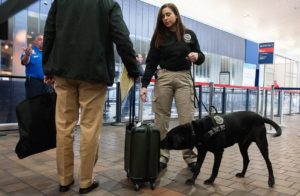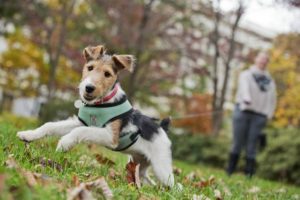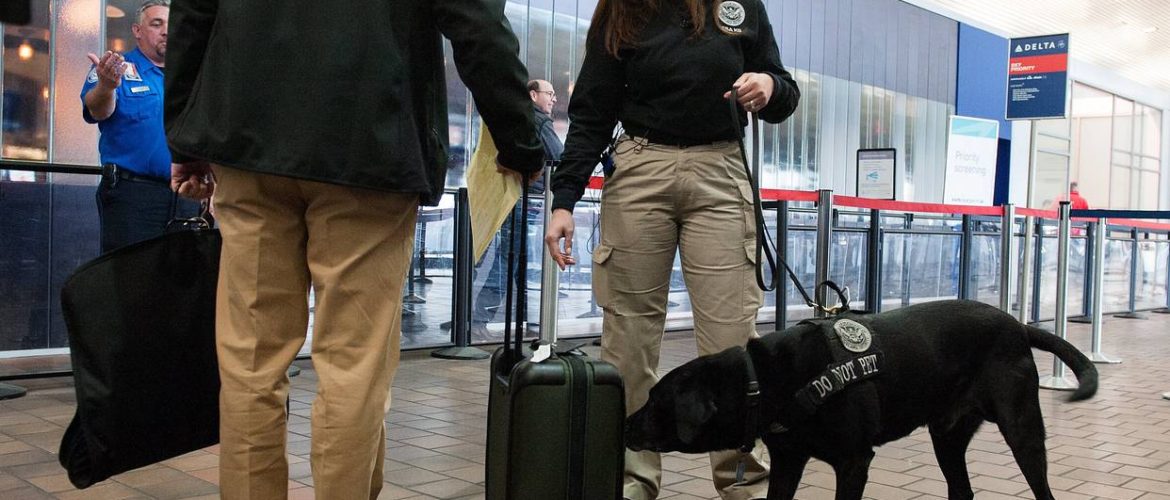No one disputes the keenness of the canine nose, though scientific evidence is skimpy

Transportation Security Administration K-9 handler Melissa Ramos and Willie, her explosive-detection dog, at LaGuardia Airport in New York. PHOTO: BRYAN THOMAS/GETTY IMAGES
By Jo Craven McGinty
March 24, 2017 5:30 a.m. ET
Dogs clearly love to smell. They snarfle their way along the sidewalk. They plant their snouts where you wish they wouldn’t. They snuffle, snort and sneeze, pulling in great gulps of air and sorting out the scents as they go.
We accept that dogs have sharp noses, and we train them to detect bombs, drugs, bodies, fugitives, pests and cancer. But our knowledge of the limits of their abilities is scant. Studies are relatively few, the number of animals tested is typically small, and the results are disparate.
A variety of things can impair a dog’s performance, from boredom to stress to cues from a handler. Their accuracy may approach perfection, but it also may dip to disturbingly low levels.
“There are not many sensors you would deploy in the real world and not know when it’s not going to work,” said Nathaniel Hall, director of the Canine Olfaction Research and Education Laboratory at Texas Tech University.
One University of California, Davis study testing the influence of handlers found that drug- and bomb-sniffing dogs were wrong more than half the time when their handlers were given erroneous information about the presence of target odors.
For such reasons, a carefully calibrated machine might be preferable to a dog.
Easier said than done.
“What’s cool about dogs is when they do come into contact with an odor, they can track it to its source,” said L. Paul Waggoner, co-director of the Canine Performance Sciences Program at Auburn University. “There is not an instrument out there that replicates a dog’s nose.”
That’s not for lack of effort.
The Defense Advanced Research Projects Agency of the U.S. Department of Defense spent $66 million between 1997 and 2010 drawing on the expertise of at least 35 different research institutions to develop sensors that could detect explosives as ably as a dog and identify other chemicals.
They couldn’t do it.
Meanwhile, scientific studies to measure the extent of dogs’ sniffing powers typically have involved few animals, and the results have varied wildly.

A widely read 1953 study documented the acutely sensitive nose of the fox terrier. PHOTO: TOM WILLIAMS/CQ ROLL CALL/GETTY IMAGES
In a frequently cited 1953 study, Walter Neuhaus, a German researcher, tested a single fox terrier and found it could detect butyric acid, sometimes described as smelling like vomit or body odor, at the astonishingly low concentration of .0004 parts per trillion.
In 1960, David G. Moulton, a researcher at the University of Pennsylvania, tested the same chemical with two crossbred Labradors. Their limit was 137 parts per trillion, or roughly 340,000 times greater than the concentration documented by Neuhaus.
Studies with other breeds and odors have also delivered mixed results.
In 1984, Deena Hope Krestel tested six beagles and found they could pick out amyl acetate, a chemical that smells like bananas, at concentrations of 52,000 to 32,600 parts per trillion.
Dianne Beidler Walker fared better in 2006 with two dogs, a Rottweiler and a standard schnauzer, that detected the same chemical at just 1.9 parts per trillion and 1.14 parts per trillion.
Differences in things such as the testing method or canine training can affect outcomes, and even with varying levels of sensitivity, the studies confirm dogs have an acute sense of smell.
Some say that validation is enough.
“Let’s talk about human search and rescue,” said Cynthia M. Otto, director of the Penn Vet Working Dog Center at the University of Pennsylvania, who has trained dogs to detect explosives, cancer and bedbugs. “We don’t care about the thresholds. We have a whole body.”
Rather than focusing on sensitivity, other studies have focused on the perfection of training techniques or determining whether dogs can be replaced.
In the 1970s, the Southwest Research Institute, working for the U.S. Army, tested the odor-detecting ability of a variety of animals compared with dogs.
Cats were excluded because they are uncooperative. Cows were left out because the idea of bomb-sniffing bovines struck the researchers as ludicrous. Sheep and goats were deemed too stupid. But dogs, pigs, ferrets, coyotes, wolves, foxes, skunks, opossums, deer and raccoons made the cut.
Surprisingly, pigs and ferrets outperformed German shepherds and Labrador retrievers, breeds often chosen for odor detection.
But overall, dogs won out because of their combination of qualities: Not only do they have strong noses, they are compatible with people, they respond to training, and—for now—they beat technology paws down.


